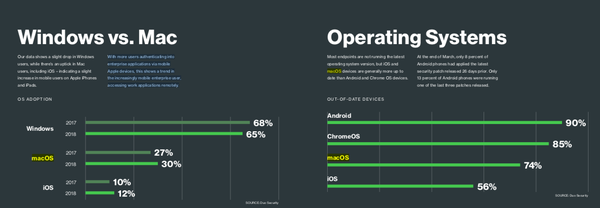
There’s been a huge surge in Windows 7 migrations to Windows 10 in business over the past year but Windows overall is shrinking, according to a report from a security firm based on 11 million enterprise users.
Windows 10 overtook Windows 7 worldwide among consumers and businesses earlier this year but Microsoft’s newest ‘as-a-service’ desktop OS that arrived i 2015 has now also taken a firm lead in enterprise.
This time last year, in the wake of WannaCry and just before NotPetya struck, Windows 7 accounted for 65 percent of devices used by Windows customers from enterprise remote authentication firm Duo Security. Back then just 27 percent of machines were on Windows 10, according to the 2018 Duo Trusted Access Report.
Fast forward to today and now 48 percent of Duo’s Windows users are on Windows 10 while 44 percent are on Windows 7.
One possible reason for the uptick in Windows 10 machines in that time were the two global malware attacks. The UK’s National Health Service (NHS) IT systems were severely disrupted by WannaCry and cited the attack as a reason for its recent Windows 10 upgrade plan.
By June last year NotPetya wiped out core systems at several global businesses, which caused chaos for Danish shipping firm, Maersk, and prompted FedEx to reconsider cyber-insurance after its European subsidiary TNT Express was crippled by the attack.
But macOS adoption has also increased over the past year, apparently at the expense of Windows. Windows adoption has fallen from 68 percent to 65 percent, while macOS adoption has increased three percentage points to 30 percent. At the same time, iOS adoption has increased from 10 percent to 12 percent.
Duo suggests this trend favoring Apple might be because more remote workers are logging into work applications via iOS devices.
“Our data shows a slight drop in Windows users, while there’s an uptick in Mac users, including iOS – indicating a slight increase in mobile users on Apple iPhones and iPads," it notes.
"With more users authenticating into enterprise applications via mobile Apple devices, this shows a trend in the increasingly mobile enterprise user, accessing work applications remotely."
The figures suggest Apple’s “Apple at Work” programs aimed at making it easier for enterprise organizations to buy, deploy and manage Apple devices is paying off.
Apple devices also fared well in a comparison of patching, performing noticeably better than Android and even ChromeOS. This is illustrated in Duo’s snapshot of devices by operating systems at the end of March which shows the proportion of each platform running the latest version.
According to Duo, 90 percent of Android devices were running an out of date OS, while 85 percent of ChromeOS devices were out of date. Meanwhile only 56 percent of iOS devices were running an out-of-date version, while 74 percent of macOS devices were.
“Most endpoints are not running the latest operating system version, but iOS and macOS devices are generally more up to date than Android and Chrome OS devices,” Duo Security comments in its report.